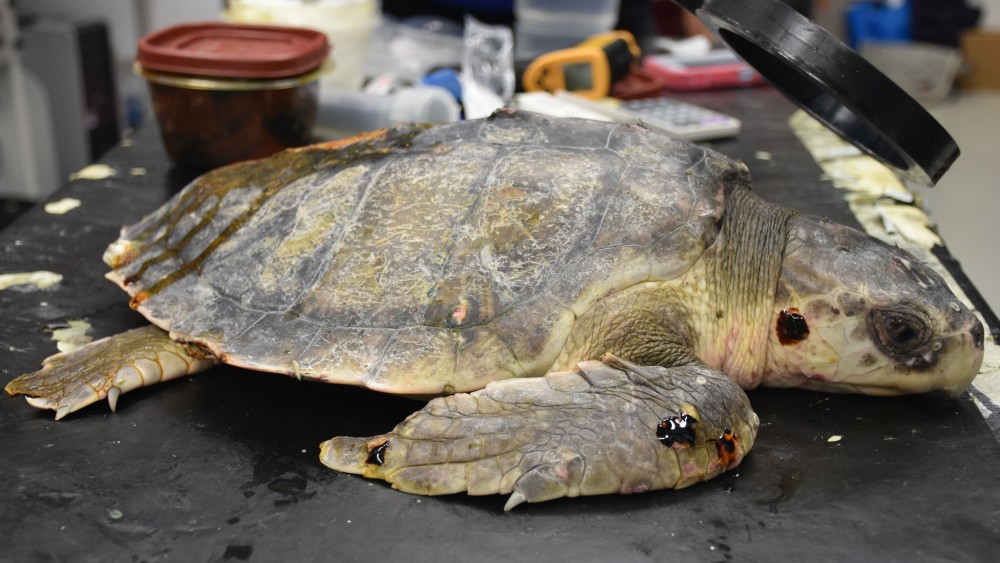Kemp’s ridley (Lepidochelys kempii)
Stranding Location: Charleston Harbor shipping channel, SC
Arrival Date: 4/20/2016
Age: Juvenile
Weight: 3.67 kg (8 lbs.)
Case History
Hopper dredges like the Glenn Edwards, which suction up sediment in order to deepen shipping channels, are responsible for the incidental capture and fatalities of numerous sea turtles within the United States. Sea turtles, although not innately social, will occasionally aggregate within the same general area where there is an abundant food source. When a dredge operation occurs in one of these areas, especially during the warmer spring and summer months, the results can be deadly. On Wednesday evening the STH received its second juvenile Kemp’s ridley dredge patient.
Treatment
Since we had just treated a similar case two days prior (Hopper), staff was able to administer all the appropriate medications and stabilize the patient relatively quickly. We decided to name this new turtle Glenn after the dredge ship. Glenn presented with dermatitis, and abrasions to the carapace/plastron which were treated topically. These injuries were likely sustained by being forced against the dredge’s metal grate under high pressure. Needless to say, this is one lucky turtle! Radiographs revealed chronic osteomyelitis in both front flippers. This type of infection of the bone is something we routinely see in our cold stun Kemp’s ridley patients, and may take over a year to resolve. Prognosis is fair.
Update
22 April 2016: Glenn is one active turtle and loves swimming around the tank! S/he seems to be feeling better and ate a small piece of Mackerel this morning. Staff will be giving antibiotic injections every three days, and will slowly increase the amount of food being offered.

7 June 2016: We were concerned when Glenn coughed up a small amount of blood shortly after arrival. This was likely due to internal lung trauma resulting from passage through the dredge equipment. Our veterinarian used x-rays and an endoscope to evaluate the internal damage and determined that both lungs are intact and not leaking air into the body cavity. However, the left lung was ~85 percent compressed by a lung bulla, essentially a bubble-like cavity filled with air that doesn’t function properly for gas exchange. Surgery was then performed to deflate the bulla, which permitted the left lung to temporarily inflate to normal size. Although the bulla did partially refill shortly after Glenn’s procedure, it is currently stable at about half of its original size. Since this little ridley will be with us long-term while s/he heals from severe osteomyelitis in both front flippers, we are going to periodically monitor Glenn’s lung bulla and are hopeful the situation may improve or resolve on its own. On a good note, Glenn is a very active turtle and eats well, although s/he occasionally struggles to dive down to the bottom of the tank.
18 August 2016: Glenn is doing very well. After an innovative surgery of injecting donor Kemp’s Ridley blood into the lung bulla, we are happy to report that the bulla is much smaller in size. This surgery was performed last month in order to form a clot, sealing the membrane and promoting healing of the tear. Since surgery, the lung bulla has been closely monitored with several CT scans. Staff is cautiously optimistic that Glenn will indeed be a candidate for release sometime down the road.
13 September 2016: We are excited to announce that Glenn has officially been cleared for release! The note from our Vet, Dr. Boylan: “I’ll be honest, it’s a little miracle. Glenn, SMP2016042002, the L. kempii that had a huge lung bulla due to the hopper dredge is medically cleared for release. Big thanks go to Mike Parks and David Sachs mentioning the autologous blood patch technique. Yea Glenn!!!” Stay tuned to the Aquarium’s Facebook page for upcoming details!
Release Date
September 22, 2016
Release Location
Isle of Palms County Park


